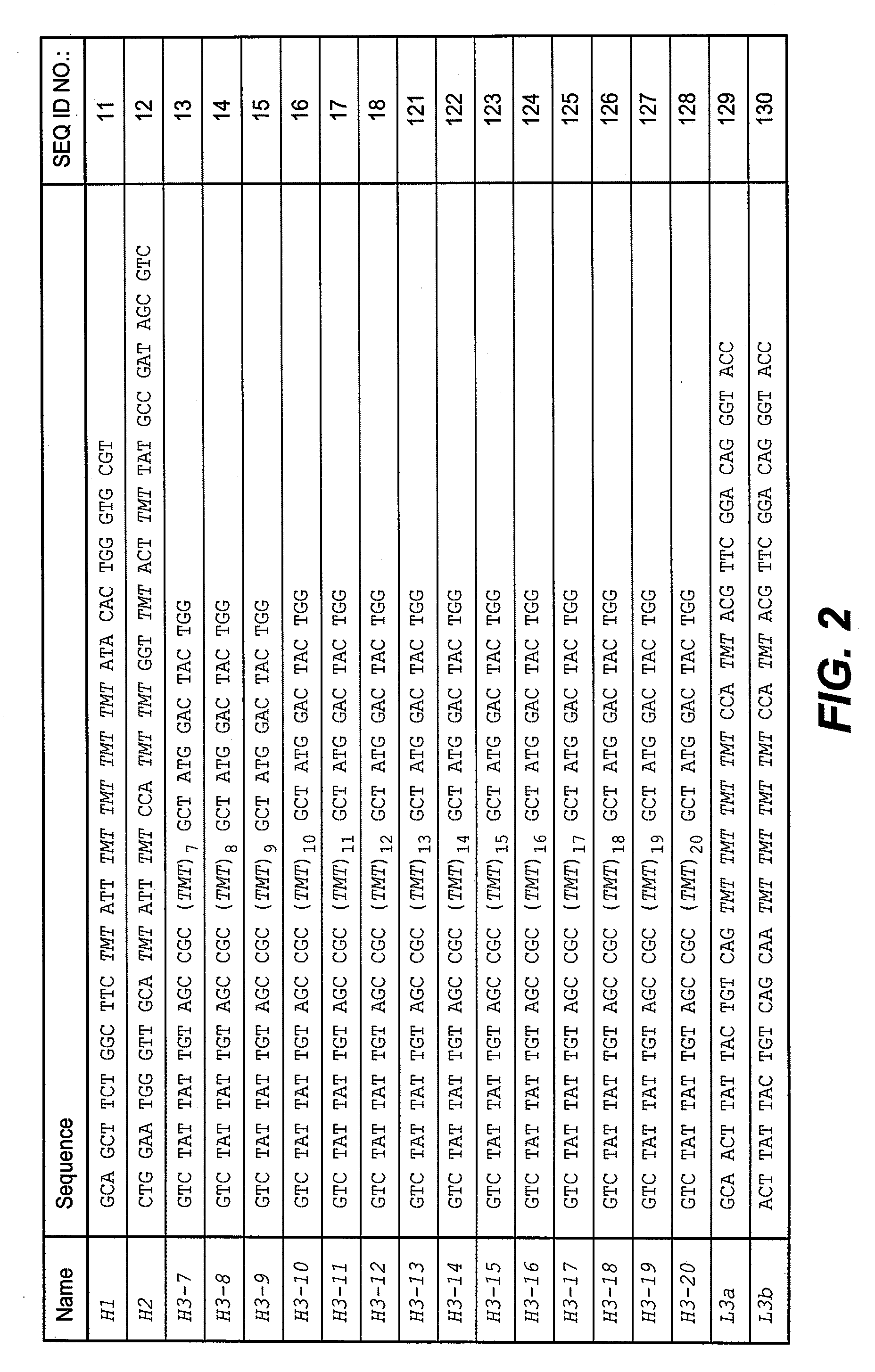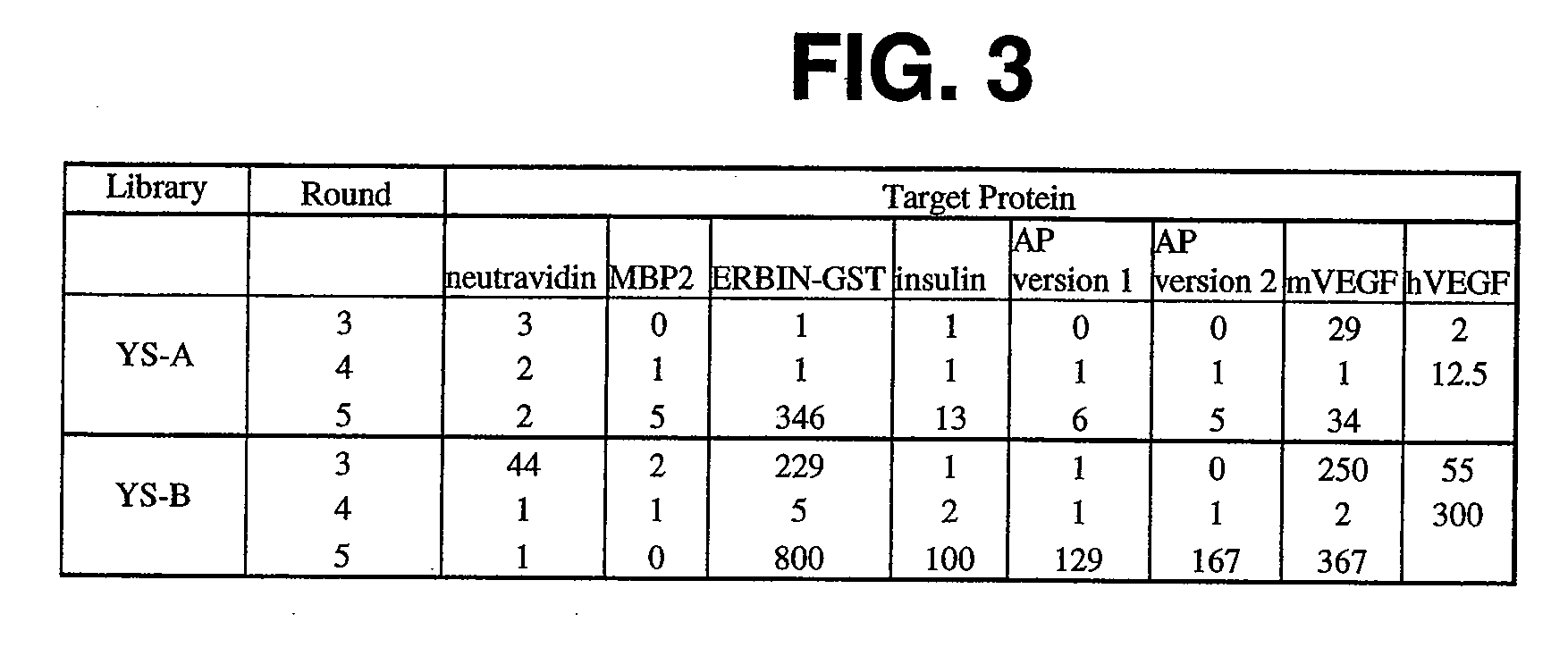Binding polypeptides with restricted diversity sequences
- Summary
- Abstract
- Description
- Claims
- Application Information
AI Technical Summary
Benefits of technology
Problems solved by technology
Method used
Image
Examples
example 1
Construction of Phage-Displayed Fab Libraries with CDR Residues Randomized as only Tyr or Ser
[0461]Phage-displayed Fab libraries were constructed using a phagemid vector that resulted in the display of bivalent Fab moieties dimerized by a leucine zipper domain inserted between the Fab heavy chain and the C-terminal domain of the gene-3 minor coat protein (P3C). This vector comprises the sequence shown in FIG. 18 (SEQ ID NO:4). The vector (schematically illustrated in FIG. 19) comprises the humanized antibody 4D5 variable domains under the control of the IPTG-inducible Ptac promoter. The humanized antibody 4D5 is an antibody which has mostly human consensus sequence framework regions in the heavy and light chains, and CDR regions from a mouse monoclonal antibody specific for Her-2. The method of making the anti-Her-2 antibody and the identity of the variable domain sequences are provided in U.S. Pat. Nos. 5,821,337 and 6,054,297.
[0462]Two libraries were constructed. Library YS-A was ...
example 2
Selection of Specific Antibodies from the Naïve Libraries YS-A and YS-B
[0467]Phage from library YS-A or YS-B (Example 1) were cycled through rounds of binding selection to enrich for clones binding to targets of interest. Eight target proteins were analyzed separately with each library: human VEGF, murine VEGF, neutravidin, an apoptosis protein (AP), maltose binding protein, erbin-GST fusion, and Insulin. The binding selections were conducted using previously described methods (Sidhu et al., supra).
[0468]NUNC 96-well MAXISORP immunoplates were coated overnight at 4° C. with capture target (5 μg / mL) and blocked for 2 h with SUPERBLOCK TBS (tris-buffered saline) (PIERCE). After overnight growth at 37° C., phage were concentrated by precipitation with PEG / NaCl and resuspended in SUPERBLOCK TBS, 0.05% TWEEN™ 20 (SIGMA), as described previously (Sidhu et al., supra). Phage solutions (˜1012 phage / mL) were added to the coated immunoplates. Following a 2 h incubation to allow for phage bind...
example 3
Construction of a Phage-Displayed Fab Library (F0505) with CDR Residues Randomized with Tetranomial Codons Encoding Four Amino Acids
[0474]Phage displayed libraries were constructed, as described in Example 1, with a previously described phagemid designed to display bivalent Fab moieties dimerized by a leucine zipper domain inserted between the Fab heavy chain and the C-terminal domain of the gene-3 minor coat protein (P3C) (as described in Example 1). CDR positions in the heavy chain were randomized, positions as shown in FIG. 1. Eleven separate mutagenesis reactions were performed with each mutagenesis reaction designed to randomize the CDR positions with a tetranomial codon that encoded for only four amino acids. In each mutagenesis reaction, the CDR positions were simultaneously replaced with only one type of tetranomial codon. The eleven tetranomial codons used for the eleven mutagenesis reactions and the amino acids they encode are shown in FIG. 6. For each mutagenesis, three m...
PUM
 Login to View More
Login to View More Abstract
Description
Claims
Application Information
 Login to View More
Login to View More - R&D
- Intellectual Property
- Life Sciences
- Materials
- Tech Scout
- Unparalleled Data Quality
- Higher Quality Content
- 60% Fewer Hallucinations
Browse by: Latest US Patents, China's latest patents, Technical Efficacy Thesaurus, Application Domain, Technology Topic, Popular Technical Reports.
© 2025 PatSnap. All rights reserved.Legal|Privacy policy|Modern Slavery Act Transparency Statement|Sitemap|About US| Contact US: help@patsnap.com



